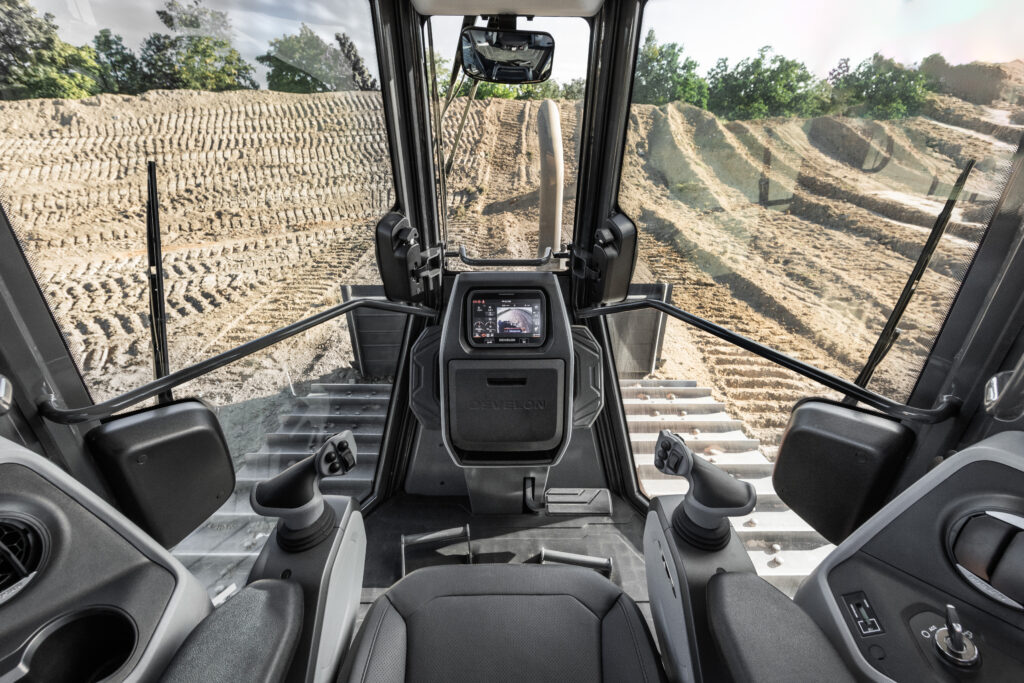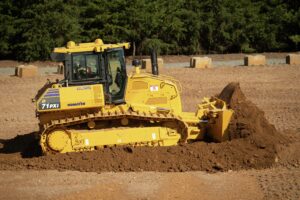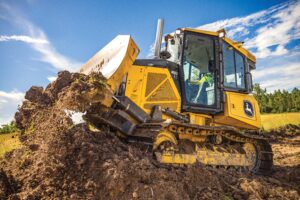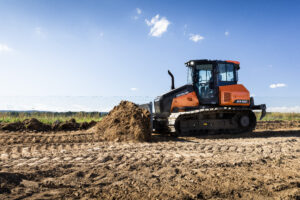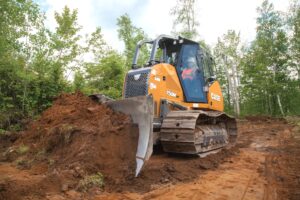
A tech assist for moving earth
By NATE HENDLEY
Construction Equipment Equipment TechnologyAutomation and user-friendly controls fill the skills gap in the earthmoving machinery sector.
Equipment manufacturers have been adding high-tech systems and software to dozers and motor graders for years. While these solutions are generally designed to enhance productivity, efficiency, and safety, earthmoving equipment is increasingly sporting “features that support a less experienced work force,” as Matt Costello, product marketing manager at John Deere, put it.
While Costello was speaking for John Deere equipment, his comments apply broadly. Fewer young people are entering the skilled trades today, and those who do take jobs in construction are often techsavvy but unfamiliar with the workings of dozers and graders. There is a trend towards fitting construction equipment with automated features and user-friendly technology to fill this skills gap, in addition to enhancing performance.
“Our approach is really about supplementing the labour force we have today, and simplifying tasks that maybe take years to learn,” says Costello. The goal, he says, is twofold. Not only are manufacturers looking to help new operators get up to speed as quickly as possible, but the technologies they develop and offer also enhance the abilities of more experienced operators. Jacob Sherman, product and dealer marketing manager at Develon agrees, noting, “In the past, the only way to gain expert capability in the jobsite was time in the seat.”
Today, this is no longer the case; Sherman points to his company’s 2D grading system, which makes it easier for inexperienced operators to master precision grading.
“There is definitely a noticeable shift in modern construction towards ‘smart machines’ where less input is required of the operator,” adds Nathan Repp, product marketing manager for Komatsu. “This trend towards machinery that requires less input means more opportunity for inexperienced operators to work on those machines and produce good results.”
The advent of Artificial Intelligence (AI), meanwhile, represents a high-tech wild card that might have a huge impact on construction equipment manufacturing going forward.
“[AI] is a key word lately in the news. There’s a lot of innovation in that sector. We are in what I would call testing and research phase of seeing how [AI] could provide some positive ROI for our customers,” says Sherman.
If AI seems like a futuristic dream, fully autonomous construction equipment also seemed like science-fiction at one point but is now a reality.
While the mining industry has used autonomous trucks for years, such vehicles operate in tunnels and other controlled environments. If a driverless mining vehicle malfunctions, damage is limited to a confined area. Construction work, by contrast, is often conducted in crowded urban settings, raising the possibility of machines running amok near schools or residential neighbourhoods.
As a result, semi-autonomous solutions, in which some machine functions are automated, but a human is still required to be in the cab, have been the norm for construction equipment.
Develon, however, recently expanded its pioneering construction machine lineup, pursuing safety as well as efficiency, and raising the possibility of driverless dozers and graders becoming commonplace on construction sites of the future.
With this in mind, here’s a look at what’s new and/or newsworthy in dozers and motor graders.
KOMATSU
Komatsu showcased three specialized dozers—the D39PXi-24, D51PXi-24, and the D71PXi-24—at CONEXPO 2023 last March in Las Vegas.
This dozer trio, which offer 105 hp, 131 hp, and 237 hp respectively, were all fitted with IMC 2.0, the latest iteration of the company’s proprietary Intelligent Machine Control (IMC). Other Komatsu dozers also sport this control.
IMC 2.0 offers “a tremendous number of improvements” over the company’s original IMC system, which was introduced a decade ago, says Rafal Bukowski, product specialist for HST Dozers, Komatsu.
“With IMC 2.0, we’ve made it very user friendly. Operators are able to set multiple shortcuts on the screen to adjust and turn IMC 2.0 features off or on, depending on their application,” he explains.
Handy IMC 2.0 features include proactive dozing control, where the machine measures terrain it traverses then uses this data to configure a new, more productive pass, and tilt steering control, where the blade is automatically adjusted to ensure straight travel in applications involving rough dozing. Lift layer control, meanwhile, enables operators to press a button to automatically spread fill from an existing surface.
The new machine control can be used to upload new plans simultaneously into multiple machines. Komatsu dozers also use Komtrax, the company’s telematics system, for performance data and other metrics.
While improving productivity and efficiency was the impetus behind the development of IMC 2.0, the machine control is ideal for operators who are either inexperienced or want to focus on the jobsite rather than joysticks, says Bukowski.
“While IMC 2.0 doesn’t enable automatic dozing—because the operator still has to be in the cab—we do make it significantly easier for the operator. Our data shows 80 per cent less operator input while using IMC 2.0 versus standard,” he states.
Komatsu has also introduced a 2D laser field install kit, for situations where 3D functionality is limited (when working indoors, under bridges or power lines, satellite connectivity to 3D systems can be impaired).
JOHN DEERE
John Deere introduced a line of new P-Tier small dozers at CONEXPO 2023 and announced high-tech updates to its GP-Series of motor graders at bauma 2022 in Munich, Germany.
The new 450 P-Tier dozer has a maximum operating weight of 8,634 kilograms, with a 3.15-metre-wide blade, and a 71-horsepower engine. The 550 P-Tier has a maximum operating weight of 9,124 kg, offers 92 hp, and also has a 3.15-metre blade, while the 650 P-Tier has a maximum operating weight of 10,198 kg, boasts a 104-hp engine and 3.25-metre blade. The Diesel Exhaust Fluid (DEF) system has been removed on the 450 P-tier, but the dozer’s engine still meets Tier 4 Final and Stage V emission standards.
The dozers offer precise hydraulics, and factory-fitted electrohydraulic (EH) controls featuring EZ Grade. That is a grade-management system that provides automatic blade corrections. Operators can also upgrade to Slope Control, so they can grade on slopes, if they wish.
Cabs in the new P-Tier dozer lineup boast eight-inch touchscreen displays and are 14 per cent larger than previous models. The hood line has been dropped seven inches on the 450 and 550 P-Tier models and five inches on the 650 P-Tier for better visibility.
John Deere also took the opportunity to reveal its futuristic hybrid/electric 850 X-Tier dozer at CONEXPO. The 850 X-Tier features a diesel engine and electric drive motors.
As “the newest member to our E-Drive fleet” the 850 X-Tier “gives customers multiple operating modes to help tailor that machine to the needs of their jobsite,” says Costello, adding that the machine offers power, maneuverability and control. The 850 X-Tier also features a surround-view camera set-up and EZ Grade.
John Deere has ambitious plans to offer over 20 electric-hybrid construction models by 2026 as it looks to establish what it calls an “electrification ecosystem” with easily accessible recharging stations and other solutions.
The company, which developed the industry’s first SmartGrade Motor Graders, showcased high-tech advancements to its GP-Series motor graders at bauma 2022. These include Auto-Gain, which automatically adjusts blade responsiveness while using John Deere’s cross slope solution, and Machine Presets, which let an operator program multiple functions into a single button.
Its GP-Series motor graders now come with Premium Circle as well, a fully sealed bearing and pinion that reduces maintenance while increasing torque and power.
DEVELON
CONEXPO 2023 had a lot of new product introductions, and Develon was not to be left out. The company introduced its DD130, only the second dozer made by the brand, and announced that it is expanded its automated construction platform.
Designed for fine grading work in residential and light commercial construction, the DD130 boasts an operating weight of 33,730 pounds and a 157-hp engine. It sports an eight-inch colour touchscreen display, all around glass cab, rear and front LED lights, and a rearview camera. The cooling system is in the rear while a downward sloping front improves visibility for the operator.
The DD130 comes standard with a six-way, 12-foot-wide angle pitch blade, Blade Shake function, heat and air conditioning, and Develon Fleet Management— the company’s telematics system. An optional 2D Blade Assist grading solution makes it easier for novice operators to grade with precision.
The DD130 also boasts Smart Key technology, which is similar to the fobs many of us use in our cars. The dozer operator keeps the Smart Key in their pocket and doesn’t need to insert it in the ignition to start the machine.
Develon also unveiled Concept-X2 at CONEXPO, an expanded version of its pioneering Concept-X platform. Introduced in 2019, Concept-X has been described by Develon as “the world’s first automated construction solution.” According to company literature, the system was developed to increase efficiency, while providing contractors with a solution to the skilled worker shortage within the construction industry.
At the show, Concept-X2 incorporated a DD100-CX dozer, the DD130’s predecessor, into the company’s autonomous equipment lineup, where the cableless DD100-CX and other autonomous Develon equipment were put through their paces.
“At CONEXPO, we demonstrated with a dozer, how sensors and cameras can work collaboratively to avoid obstructions [or detect] someone walking behind dozer or any type of obstacle,” says Sherman. Develon calls its emergency stop feature E-Stop. When E-Stop detects the presence of a person or machine, it automatically halts the machine.
CASE
CASE recently overhauled its 650M, 750M and 850M Series dozers, putting a focus on the operator and their needs.
“We believe that an operator-first mindset in the design helps keep operators happier, and more comfortable and productive,” explains Jeremy Dulak, North American product and marketing manager for Dozers and Compaction at CASE Construction Equipment.
The electrical and hydraulic systems on M Series dozers were redesigned with an emphasis on durability, reliability and serviceability, he explains. He says that main features of the electrical redesign included improved retention frequency, new braided chassis harness, and the use of strategic jumper harnesses for brake valve, pumps, engine, and horn. Hydraulic improvements included splitting up the main manifold, once found in the centre of the chassis, to augment routings, access and repairability. Zip ties on hoses and stacked fittings were also eliminated, reducing potential leaks.
“The 650M dozers have new and improved mechanical control, providing a reduced lever effort by over 20 per cent, reduced float time and reduced interior cab noise,” says Dulak. “The 750M and 850M models have a new electrohydraulic control valve enabling EH blade control as standard, just like the larger CASE dozers.”
Revamped M Series dozers also boast Bluetooth radio, and ergonomic joysticks to reduce operator fatigue. CASE Universal Machine Control is optional for the 750, 850, 1150, 1650 and 2050 M-Series dozers, enabling them to be fitted with machine control systems from various suppliers. These dozers can also be equipped with factory-fitted Leica Geosystems.
Safety is enhanced by LED lights, with four in the front and two in the rear, and an optional rear-view camera. A low sloping front hood design ensures “good forward visibility,” adds Dulak.
Nate Hendley is a freelance writer and author, and is a regular contributor to On-Site Magazine.

